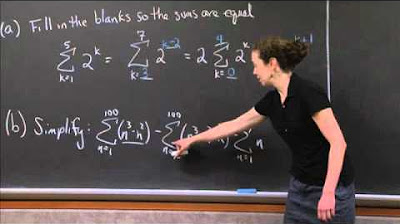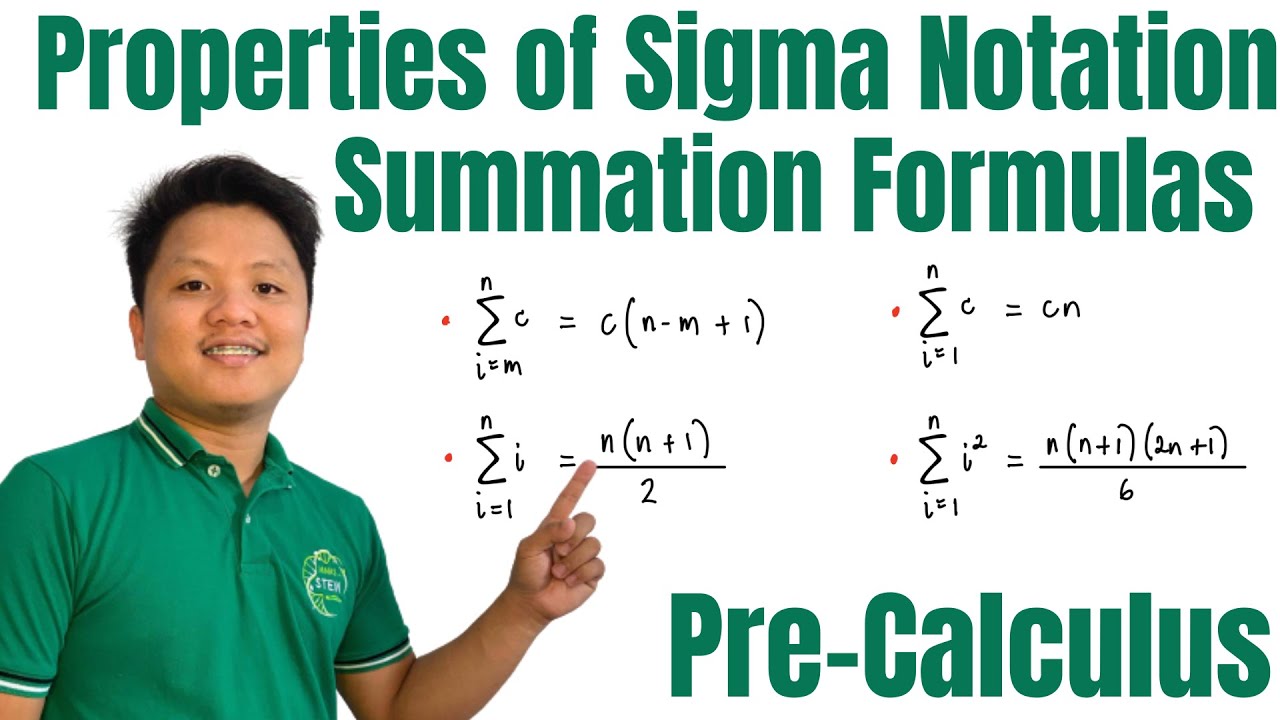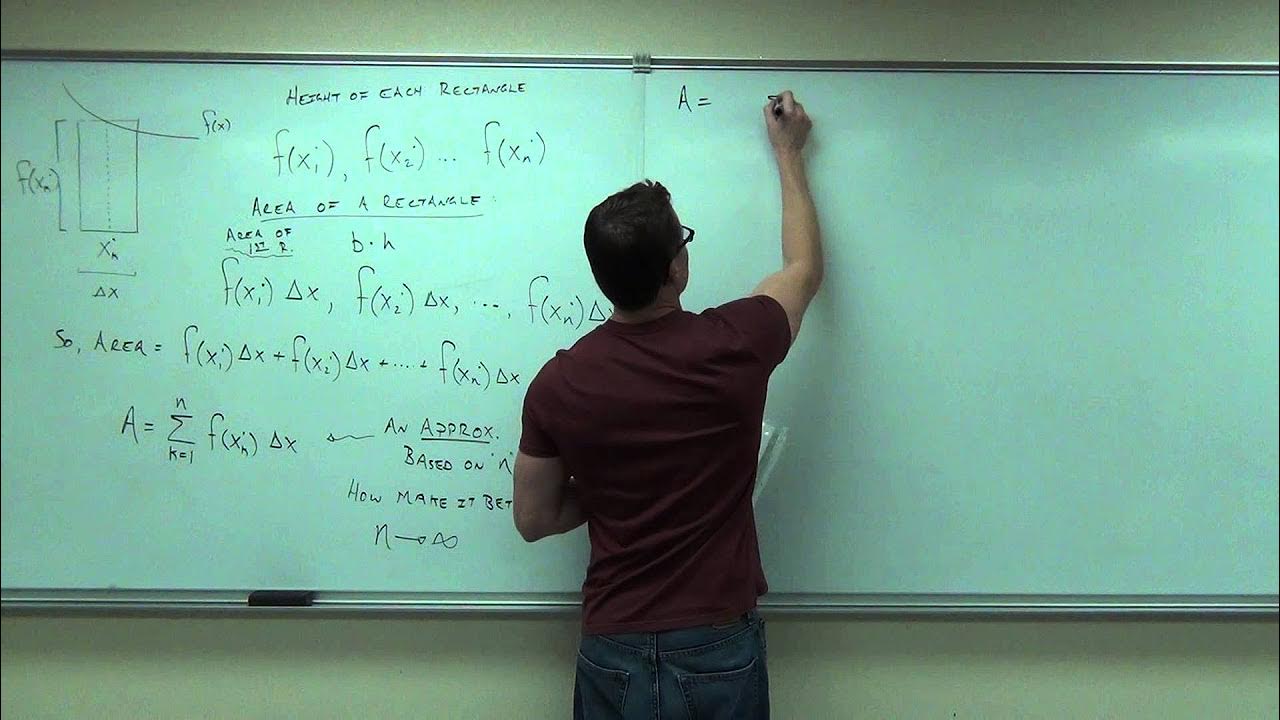Writing Summations in Sigma Notation | Series and Sigma Notation | Pre-Calculus
TLDRThis educational video tutorial teaches viewers how to express sequences of numbers using sigma notation, a mathematical shorthand for summation. The host begins by explaining the basic structure of sigma notation, including the lower and upper bounds, and then provides three examples to illustrate the process. The first example involves summing powers of two, the second sums a series of fractions with ascending denominators, and the third example demonstrates a pattern of alternating signs multiplied by increasing integers. Each example is broken down step by step, showing how to identify the pattern, set the bounds, and write the expression in sigma notation. The video concludes with an invitation for viewers to ask questions or seek clarifications in the comments section.
Takeaways
- 📚 The video is a tutorial on how to write expressions in sigma notation, a mathematical notation used to represent the sum of a sequence of terms.
- 🔢 Sigma notation is expressed as the summation of f(i) from i equals m to n, where 'f(i)' is the expression involving an integer 'i', 'm' is the lower bound, and 'n' is the upper bound.
- 🌟 The first example given is a sequence of powers of two: 1 + 2 + 4 + 8 + 16 + 32, which can be written in sigma notation as \( \sum_{i=0}^{5} 2^i \).
- 📈 The second example involves a series of fractions: 1 + 1/2 + 1/3 + ... + 1/100, which can be represented as \( \sum_{i=1}^{100} \frac{1}{i} \).
- 🔄 The third example is a sequence with alternating signs: -1 + 2 - 3 + 4 - 5 + ... - 25, which can be written as \( \sum_{i=1}^{25} (-1)^i \cdot i \).
- 👨🏫 The video is presented by a professor, referred to as 'Prof D', who guides the viewers through the process of converting sequences into sigma notation.
- 🔑 The key to converting a sequence into sigma notation is identifying the pattern of the sequence and determining the appropriate lower and upper bounds.
- 📝 Sigma notation is a compact way to express the sum of a series, making it easier to work with in mathematical calculations.
- 📉 The video provides a step-by-step approach to identifying the terms and bounds for each example sequence.
- 🤔 The video encourages viewers to ask questions or seek clarifications in the comments section if they have any doubts about the process.
- 👋 The video concludes with a sign-off from Prof D, indicating the end of the tutorial.
Q & A
What is sigma notation and how is it used in the video?
-Sigma notation is a mathematical shorthand used to represent the sum of a sequence of terms. In the video, it is used to compactly write the sum of an expression involving an integer 'i' from 'm' to 'n', where 'f(i)' is the expression for each term.
What are the lower and upper bounds in sigma notation?
-The lower bound in sigma notation is the starting value of the index 'i', and the upper bound is the ending value. In the video, the lower bound is denoted by 'm', and the upper bound is denoted by 'n'.
How does the video illustrate the first example of sigma notation with powers of two?
-The video illustrates the first example by showing the sum of powers of two: 1 (2^0), 2 (2^1), 4 (2^2), 8 (2^3), 16 (2^4), and 32 (2^5). The sigma notation for this sequence is written as ∑(2^i) from i=0 to i=5.
What is the expression 'f(i)' in the context of the first example in the video?
-In the context of the first example, 'f(i)' represents 2 raised to the power of 'i', which is written as 2^i.
Can you explain the second example given in the video involving fractions?
-The second example involves a sum of fractions: 1 + 1/2 + 1/3 + ... + 1/100. The video explains that this can be written in sigma notation as ∑(1/i) from i=1 to i=100.
What is the significance of the denominators in the second example?
-The significance of the denominators in the second example is that they represent the index 'i' in the sigma notation, starting from 1 and going up to 100.
In the third example, how does the video describe the alternating pattern of positive and negative terms?
-The third example shows an alternating pattern of positive and negative terms: -1, 2, -3, 4, ..., -25. The video describes this pattern by multiplying each term by (-1)^i, where 'i' is the index of the term.
What is the expression 'f(i)' for the third example in the video?
-For the third example, 'f(i)' is represented as (-1)^i * i, which captures the alternating sign and the value of the term.
How does the video suggest determining the lower and upper bounds for the third example?
-The video suggests determining the lower and upper bounds by observing the pattern of the terms. The lower bound is set to 1, as the sequence starts with -1 (which is -1^1 * 1), and the upper bound is 25, as the sequence ends with -25 (which is -1^25 * 25).
What is the final sigma notation for the third example presented in the video?
-The final sigma notation for the third example is ∑((-1)^i * i) from i=1 to i=25.
What advice does the video give for those who have questions or need clarifications?
-The video advises viewers to leave their questions or clarifications in the comment section below for further discussion or assistance.
Who is the presenter of the video and how does he sign off?
-The presenter of the video is referred to as 'Prof D'. He signs off by saying 'I'll catch you on the flip side', indicating that he will see the viewers in the next video.
Outlines
📚 Introduction to Sigma Notation
This paragraph introduces the concept of sigma notation, a mathematical shorthand used to represent the sum of a sequence of terms. The instructor explains that an expression involving an integer 'i' can be written in sigma notation, denoted by the summation symbol (∑), with 'f(i)' representing the expression. The notation includes a lower bound 'm' and an upper bound 'n', which define the range of the summation. An example is given to illustrate the process, where the sum of powers of two from 2^0 to 2^5 is compactly written using sigma notation.
🔍 Examples of Sigma Notation Application
The second paragraph delves into applying sigma notation to various examples. The first example involves summing powers of two, which is translated into sigma notation with the lower bound assumed as zero and the upper bound as five. The second example discusses a series of fractions with ascending denominators, which are summed from one to one hundred in sigma notation. The third example demonstrates a series with alternating signs, which is transformed into sigma notation by multiplying each term by (-1) raised to the power of the term's position, with bounds from one to twenty-five.
👋 Conclusion and Sign-off
In the concluding paragraph, the instructor wraps up the lesson on writing expressions in sigma notation. They encourage viewers to ask questions or seek clarifications in the comment section if needed. The sign-off is casual and friendly, with the instructor expressing hope that the viewers have learned how to write expressions in sigma notation and bidding them farewell until the next video.
Mindmap
Keywords
💡Sigma Notation
💡Expression
💡Lower Bound
💡Upper Bound
💡Power of Two
💡Fraction
💡Denominator
💡Negative One Raised to a Power
💡Series
💡Prof D
Highlights
Introduction to writing expressions in sigma notation.
Explanation of f(m) + f(m+1) + f(m+2) ... f(n) in sigma notation.
Sigma notation compactly writes sums with lower and upper bounds.
Example 1: Sum of powers of two expressed in sigma notation.
Identification of terms as powers of two (2^n).
Sigma notation for powers of two from 2^0 to 2^5.
Example 2: Sum of fractions with ascending denominators.
Rearrangement of terms to identify lower and upper bounds.
Sigma notation for the sum of one over i from i=1 to i=100.
Example 3: Sum of alternating series with negative terms.
Multiplication of each term by (-1)^n to identify pattern.
Sigma notation for alternating series from i=1 to i=25.
Pattern recognition in sigma notation for different types of series.
Understanding the importance of lower and upper bounds in sigma notation.
Practical application of sigma notation in summing series.
Encouragement for viewers to ask questions or seek clarifications.
Closing remarks and sign-off by Prof D.
Transcripts
Browse More Related Video

Sigma notation for sums | Sequences, series and induction | Precalculus | Khan Academy

Summation Notation Practice | MIT 18.01SC Single Variable Calculus, Fall 2010

Summation Formulas and Sigma Notation - Calculus

Properties of Sigma Notation and Summation Formulas | Pre-Calculus

Calculus 1 Lecture 4.3: Area Under a Curve, Limit Approach, Riemann Sums

Differentiating power series | Series | AP Calculus BC | Khan Academy
5.0 / 5 (0 votes)
Thanks for rating: